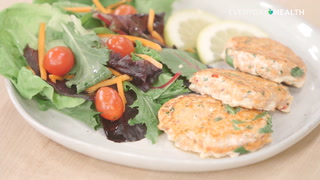
Diabetes Meal Plan: Salmon Cakes

Next up video playing in 10 seconds
Salmon for Heart-Healthy Omega-3s

Jill Weisenberger, CDCES, RD, a certified diabetes care and education specialist in Newport News, Virginia, and the author of The Beginner’s Guide to What to Eat With Type 2 Diabetes, suggests coating cooked salmon with this heart-healthy dressing: 1 tablespoon (tbsp) olive oil, 1½ tbsp lemon juice, 2 crushed garlic cloves, and a handful of fresh chopped basil. “Every single ingredient is heart-healthy and perfect for people with type 2 diabetes,” she says. Add a salad, roasted vegetables like broccoli or asparagus, and a whole-grain like brown rice for a balanced meal, she adds.
Tilapia for Tons of Protein and Little Fat

Tilapia is also fairly easy to find as both a fresh and frozen fillet, and it cooks quickly. Try this diabetes-friendly tilapia dish from Weisenberger: Sauté onions, peppers, or whatever vegetables you have on hand in a pan. Then add canned tomatoes, tomato sauce (look for low-sodium options), and Italian seasonings. Raise the heat to a low boil and place the tilapia on top. Cover and cook for a few minutes, or until the fish is cooked through. “I’d serve it with brown rice, barley, or quinoa,” Weisenberger says.
Cod for a Versatile, Low-Calorie Meal

Another great way to prepare cod is to cut it into chunks, add your favorite veggies, herbs, spices, and a drizzle of olive oil. Wrap each portion in aluminum foil and bake. “This is a great way to give each family member their own personalized meal,” Weisenberger says. “I might choose onions and broccoli, and you might choose mushrooms and asparagus.”
Trout for Heart-Healthy Fatty Acids

If you know someone who fishes, hope that you get treated to a fresh trout or bass. “Fattier fish like trout contain higher amounts of omega-3 fatty acids,” says Julie Stefanski, RD, CDCES, who is based in York, Pennsylvania.
Aim to go easy on the salt or make meals salt-free with just a touch of flavorful herbs.
Shrimp for Calorie Control and a Hearty Helping of Protein

Other Shellfish for Portion Control

But if you add melted butter, both fat and calories can skyrocket. “Instead, try incorporating shellfish into plant-based meals such as salads and stir-fries with tons of colorful veggies,” Stefanski says. Try a bay leaf seasoning in the cooking water for extra zest rather than salting the cooking liquid. And get creative: Use cooked seafood in recipes from cold salads to pasta, rice dishes, and soups.
Canned Tuna and Salmon for Your Budget

Fresh or frozen seafood is a delicious addition to a diabetes diet, but it can be expensive. Meanwhile, canned tuna and canned salmon are more affordable shelf-stable staples you can keep in your pantry. And they do count as part of your fish-eating goal for the week. “Most people don’t include enough fish in their diets, but with this easy option, they may reach the goal of two to three servings of fish per week,” Stefanski says.
For an easy, filling meal, mix one can of tuna with a bit of avocado, a touch of mayo if desired, and lemon pepper seasoning, Stefanski says. Then spread the mixture over whole-wheat toast.
Sardines for Flavor and Nutrients

The Takeaway
- Seafood can be a great addition to your diabetes-friendly diet because it’s high in protein and healthy fats, often low in calories, and packed with many vitamins and minerals.
- Health experts generally suggest eating two servings of fish each week to support heart health.
- Salmon and sardines, in particular, are rich in omega-3 fatty acids, which are a type of healthy fat that can support heart health and reduce the risk of certain diabetes complications, such as heart disease and stroke.
- Grill, bake, and broil seafood rather than breading or frying it, to avoid additional carbs and calories in your dish.
Resources We Trust
- Mayo Clinic: Diabetes Diet: Create Your Healthy-Eating Plan
- Centers for Disease Control and Prevention: Diabetes Meal Planning
- U.S. Food and Drug Administration: Advice About Eating Fish
- Johns Hopkins Medicine: Healthy Fish to Eat
- American Diabetes Association: Let’s Talk About Protein for People With Diabetes


